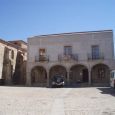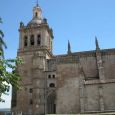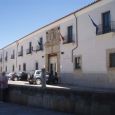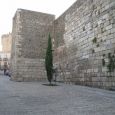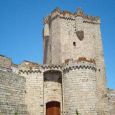Coria
Advertisement
By air
Nearest airports to Coria are sorted by the distance to the airport from the city centre.
Monfortinho Airport (distanced approximately 31 km)
Casatejada Caceres Airport (distanced approximately 74 km)
El-Pino Caceres Airport (distanced approximately 81 km)
Covilha Airport (distanced approximately 86 km)
Covilha Hel Airport (distanced approximately 89 km)
By Roads
EX-108 - East of the town - Take Argemir Puebla, El Batan, Alagón River, Galisteo and San Gil, ending at the N-630 from which you can go to Plasencia. It has secondary outputs Morcillo and Jerte Aldehuela.
EX-109 - North of the town - Take Moral and Perales del Puerto, with secondary outputs Calzadilla, Casas de Don Gomez and Huelago.
EX-109 - South of the town - Take Torrejoncillo and Portezuelo with secondary outputs Corner Bishop and Portaje.
CC-43 - Northeast of the town - Take Guijo de Coria.
CC-59 - West of the town - Take Casillas de Coria.
Public Transport
The station bus is Coria Guijo street. On the street closure from a stop taxi. In addition, there Navalmoral Highway Transportation Service Center.
Castillo de Coria
Coria Castle is located in the town of Coria, in the province of Caceres.It was built in the year 1472 by the Duke of Alba, is located on the northwest of the original Roman wall of the municipality. This is a late Gothic building, having been the architect Juan Carrera. It consists of a main tower of pentagonal plan. In front stands a semicircular turret. The set is finished with battlements and a semicircular booth on each side. The entire perimeter is decorated with arches and balls.
Cathedral of Santa Maria Assunta de Coria
The cathedral is located in Coria Coria, Extremadura, in Spain. Its current building, located where the old were Visigoth cathedral, the mosque of the city and the former Romanesque cathedral church, started in the year 1498, ending it 250 years later, around 1748. The Lisbon earthquake occurred on November 1 of 1755 damaged it seriously.The cathedral is gothic transition, with important additions platerescos.
Cathedral Museum
The cathedral cloister enabled in the fourteenth and fifteenth centuries, shows important sacred works of the XIV-XIX Mantel highlighting the relic of the Lord's Supper and elaborate seventeenth-century colonial chest, a handwritten page of the "Summa "St. Thomas Aquinas, a very interesting collection of paintings on copper School of Rubens and images of San Miguel and San Sebastian carved by Salvador Carmona.
Bishop's Palace
Bishop's Palace was built in 1628 on the old "Episcopal Homes" in Baroque style, by order of Bishop Jerome Ruiz Camargo. Defensive tower retains flavor Mudejar brick. It has recently been renovated and converted into a luxury hotel.
Shrine of Our Lady of Argemir
Shrine of Our Lady of Argemir, baroque of the seventeenth century, the subject of very recent restoration and reopening after decades of neglect. Fresco decorated dome and high altarpiece s. XVIII. Holder retains the image pattern of the city and the Diocese, a twelfth-century Black Madonna .
Palace of the Dukes of Alba
The XV-XVI. Built in Gothic-Renaissance style, combining elements of military stronghold and stately palace, in which stand two Moorish patios and spectacular gardens, gazebo with belbedere XVI century Renaissance. Today belongs to the family of Rafael Sanchez Ferlosio, Cauriense glory of literature and Cervantes Prize.
Church of Santiago
Church of Santiago, Baroque XVI-XVIII centuries, retains steeple baroque design Churriguera Manuel Lara. Recently restored the high altar of the sixteenth century Mannerist reliefs with major Berruguete style. In its movable heritage is worth highlighting the image of Christ of the Afflicted, the fifteenth century.
Convent of the Mother of God
Convent of the Mother of God, run by Franciscan TOR and founded in the thirteenth century, although the current building corresponds to the XIV-XVI. Century church Sixteenth century Baroque altarpiece Seventeenth-century Rococo side altars XVIII. Superb faculty Renaissance of the sixteenth, with well and trapezoidal paved with the Mudejar and a collection of paintings and ivories, highlighting a table of Pedro Machuca.
March - October


